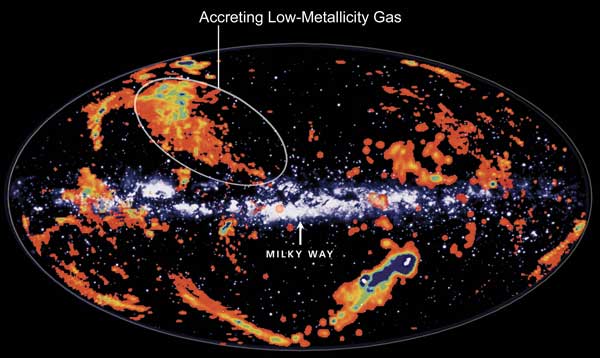
|
Credit & Copyright: B. Wakker
(U. Wisconsin-Madison) et al.,
NASA
Explanation:
Where are these gas clouds going so quickly?
High velocity clouds (HVCs) of gas
have been seen for decades but their origins and
destinations have remained mysterious.
Recent measurements have now placed at least
one of these clouds in the halo of our
Milky Way Galaxy, while other measurements
have determined the relative abundance of cloud elements.
Of the two clouds measured, each appears to have a
chemical abundance consistent with a different origin.
One HVC has been measured to have very few heavy elements
("low metallically") compared to neighboring stars,
while another HVC has been inferred to have a
heavy element abundance more typical of neighboring stars.
Hypotheses are therefore being investigated that
some HVCs are local gas remnants being
pushed away from our Galaxy by
supernova explosions, while other
HVCs are ancient
dwarf galaxy
remnants falling toward our Galaxy.
The latter possibility is particularly
interesting as it might help explain how our
Galaxy can continue to
make stars at the observed rate.
Fast moving HVCs are circled in the above false-color mosaic.
|
January February March April May June July August September October November December |
| ||||||||||||||||||||||||||||||||||||||||||||||||
NASA Web Site Statements, Warnings, and Disclaimers
NASA Official: Jay Norris. Specific rights apply.
A service of: LHEA at NASA / GSFC
& Michigan Tech. U.
Based on Astronomy Picture
Of the Day
Publications with keywords: high velocity clouds - Milky Way
Publications with words: high velocity clouds - Milky Way
See also:
- APOD: 2025 February 9 Á Milky Way over the Australian Pinnacles
- APOD: 2024 November 24 Á Journey to the Center of the Galaxy
- APOD: 2024 November 5 Á Milky Way over Easter Island
- APOD: 2024 August 4 Á Gaia: Here Comes the Sun
- APOD: 2024 July 29 Á Milky Way over Uluru
- APOD: 2024 May 29 Á Stairway to the Milky Way
- APOD: 2023 December 12 Á Aurora and Milky Way over Norway
